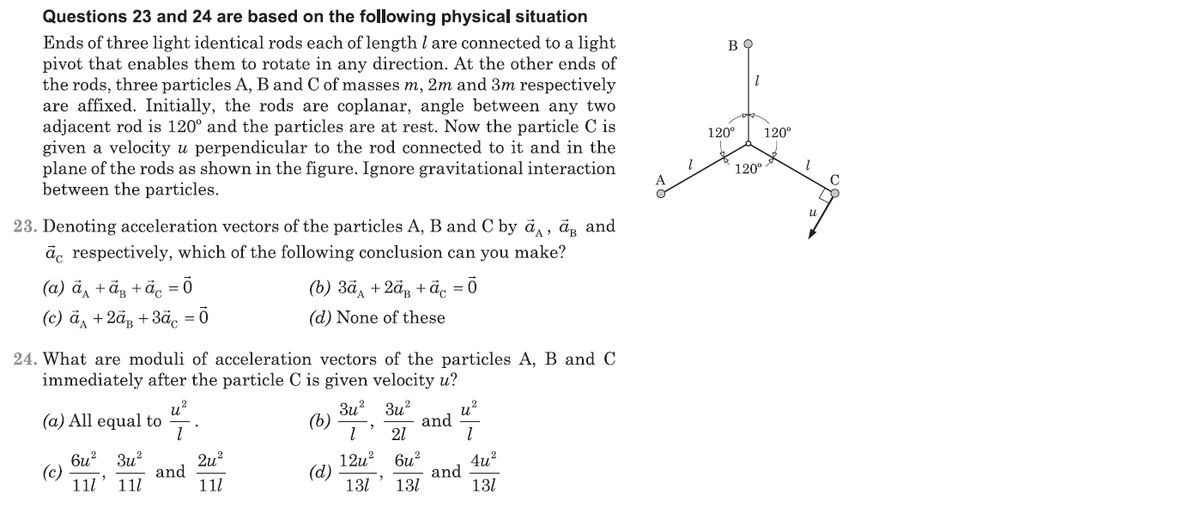Questions 23 and 24 are based on the following physical situation Ends of three light identical rods each of length l are connected to a light pivot that enables them to rotate in any direction. At the other ends of the rods, three particles A, B and C of masses m, 2m and 3m respectively are affixed. Initially, the rods are coplanar, angle between any two adjacent rod is 120° and the particles are at rest. Now the particle C is given a velocity u perpendicular to the rod connected to it and in the plane of the rods as shown in the figure. Ignore gravitational interaction between the particles. BO 120° 120° 120° * 23. Denoting acceleration vectors of the particles A, B and C by ä,, ä, and ā, respectively, which of the following conclusion can you make? (а) ӑ, +ӑ, +ӑ, - ӧ () Зӑ, + 2ӑр + d, - ӧ (с) ӑ, + 2ӑ, + 3ӑ, — ӧ (d) None of these 24. What are moduli of acceleration vectors of the particles A, B and C immediately after the particle C is given velocity u? Зи? Зи? and 21 (a) All equal to (b) u? 6u? 3u? 2u? and 11l' 11l 12u? (d) 131 6u? 4u? and 131 (c) 111 131
Questions 23 and 24 are based on the following physical situation Ends of three light identical rods each of length l are connected to a light pivot that enables them to rotate in any direction. At the other ends of the rods, three particles A, B and C of masses m, 2m and 3m respectively are affixed. Initially, the rods are coplanar, angle between any two adjacent rod is 120° and the particles are at rest. Now the particle C is given a velocity u perpendicular to the rod connected to it and in the plane of the rods as shown in the figure. Ignore gravitational interaction between the particles. BO 120° 120° 120° * 23. Denoting acceleration vectors of the particles A, B and C by ä,, ä, and ā, respectively, which of the following conclusion can you make? (а) ӑ, +ӑ, +ӑ, - ӧ () Зӑ, + 2ӑр + d, - ӧ (с) ӑ, + 2ӑ, + 3ӑ, — ӧ (d) None of these 24. What are moduli of acceleration vectors of the particles A, B and C immediately after the particle C is given velocity u? Зи? Зи? and 21 (a) All equal to (b) u? 6u? 3u? 2u? and 11l' 11l 12u? (d) 131 6u? 4u? and 131 (c) 111 131
Algebra & Trigonometry with Analytic Geometry
13th Edition
ISBN:9781133382119
Author:Swokowski
Publisher:Swokowski
Chapter7: Analytic Trigonometry
Section7.2: Trigonometric Equations
Problem 100E
Related questions
Question
I have posted a problem for its solution. You have send me a solution which I termed as incorrect as it didn't match with the answers given in the text book. Can you send me a correct solution? Correct options for both questions 23 and 24 is (c) and (c). I post the problem again as image. Please help me.

Transcribed Image Text:Questions 23 and 24 are based on the following physical situation
Ends of three light identical rods each of length l are connected to a light
pivot that enables them to rotate in any direction. At the other ends of
the rods, three particles A, B and C of masses m, 2m and 3m respectively
are affixed. Initially, the rods are coplanar, angle between any two
adjacent rod is 120° and the particles are at rest. Now the particle C is
given a velocity u perpendicular to the rod connected to it and in the
plane of the rods as shown in the figure. Ignore gravitational interaction
between the particles.
120°
120°
120°
23. Denoting acceleration vectors of the particles A, B and C by ā, ä, and
āc respectively, which of the following conclusion can you make?
(а) ӑд + ӑз + ӑ, -ӧ
(c) ā, +2ãg +3ãc = Ō
(b) 3ã, +2ã, + äc = 0
(d) None of these
24. What are moduli of acceleration vectors of the particles A, B and C
immediately after the particle C is given velocity u?
,2
(a) All equal to
3u? 3u?
and
21
u?
(b)
би? Зи?
2u?
and
11l
12u? 6и?
and
131
4u?
(c)
11l' 111
(d)
131
131
Expert Solution
This question has been solved!
Explore an expertly crafted, step-by-step solution for a thorough understanding of key concepts.
Step by step
Solved in 3 steps

Recommended textbooks for you

Algebra & Trigonometry with Analytic Geometry
Algebra
ISBN:
9781133382119
Author:
Swokowski
Publisher:
Cengage

Linear Algebra: A Modern Introduction
Algebra
ISBN:
9781285463247
Author:
David Poole
Publisher:
Cengage Learning

Trigonometry (MindTap Course List)
Trigonometry
ISBN:
9781305652224
Author:
Charles P. McKeague, Mark D. Turner
Publisher:
Cengage Learning

Algebra & Trigonometry with Analytic Geometry
Algebra
ISBN:
9781133382119
Author:
Swokowski
Publisher:
Cengage

Linear Algebra: A Modern Introduction
Algebra
ISBN:
9781285463247
Author:
David Poole
Publisher:
Cengage Learning

Trigonometry (MindTap Course List)
Trigonometry
ISBN:
9781305652224
Author:
Charles P. McKeague, Mark D. Turner
Publisher:
Cengage Learning

Elementary Geometry For College Students, 7e
Geometry
ISBN:
9781337614085
Author:
Alexander, Daniel C.; Koeberlein, Geralyn M.
Publisher:
Cengage,